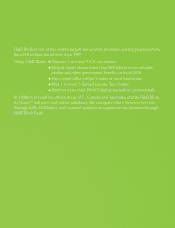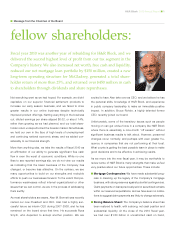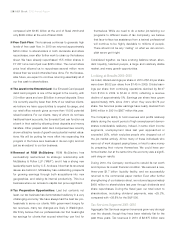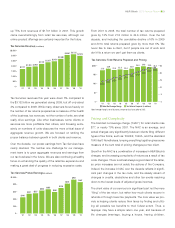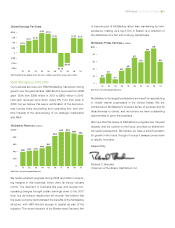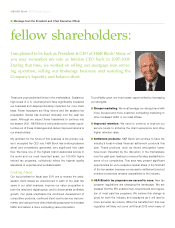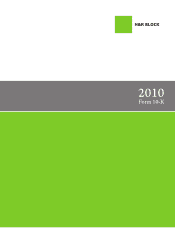HR Block 2010 Annual Report Download - page 6
Download and view the complete annual report
Please find page 6 of the 2010 HR Block annual report below. You can navigate through the pages in the report by either clicking on the pages listed below, or by using the keyword search tool below to find specific information within the annual report.
4 n H&R Block 2010 Annual Report
starting a business, and so on) that same taxpayer may have a
more complicated and more expensive return the next year.
What counts every year is how much our assistance helped
each client save in taxes and time. The more change occurs in
the Tax Code, the more valuable our services are to help cli-
ents adjust to new requirements and benefits, and the more the
NAC may increase due to more complexity in client returns.
The last decade saw a major expansion of the earned income
tax credit (“EITC”) at the federal level, and adoption or changes
of the earned income tax credit in 22 states as well. EITC is a
major factor for many of our clients. There were also enormous
and widespread changes in income tax as the Clinton tax
regime gave way to the Bush tax cuts. That led to hundreds of
changes in tax rates on income, dividends and capital gains,
inclusions or exclusions of income, changes in child care credits
and allowances, and credits for dozens of different programs.
Investment tax credits to incentivize business investment after
the events of 9/11 benefitted millions of clients, and in 2008 there
was an extensive tax rebate program to stimulate the economy.
The Alternative Minimum Tax or AMT was also a growing head-
ache for millions of Americans, adding to the complexity of their
returns throughout the decade. The Obama Administration has
already made a large number of changes, with more on the hori-
zon. Literally all of these changes are reflected in changes in our
NAC as the complexity of client returns increases. However,
every time our professionals find a client hundreds or thousands
of dollars in refunds that they would have missed doing it them-
selves, we know we have helped that family, and helped ease
the overall burden of taxation.
After adjusting for inflation, the $77 increase in the NAC over
the decade was a real increase of $42, or less than 4% per
year. After adjusting for inflation, from 2007–2010 the NAC has
increased just under $15 per return, or an annual average
increase of less than $5.
In 2010, the NAC increased by only $2, or 1%. Basic form rates
were not increased, so that essentially the entire increase
resulted from increases in taxpayer return complexity. Our
recent price restraint has helped improve our basic client value
proposition, although that job is not over. There is a multiyear
dimension to pricing decisions, as if we hold the line on price
in any given year, we increase our flexibility to raise prices in
following years.
An important change took place in 2009 in our pricing, when
we introduced “free” federal tax preparation through our online
offerings. We expanded our promotional efforts in this area in
2010, and will continue to do so in the future. Our free service
doesn’t provide all the functionality of paid online or assisted
returns, and many clients ultimately upgrade to a fee-paying
product. However, we offer a capable free service because we
believe that every American taxpayer should have the option if
they wish to prepare their taxes using one of our online programs
without charge. Whether it is because of a very simple tax
position, or because of economic need, we want to make sure
that every client can take advantage of our expertise, no matter
what fee they ultimately pay. Today’s client who uses a free
service will hopefully convert to a fee-paying client in the future.
Earnings 2001–2010
Diluted earnings per share have grown from $0.76 per share in
2001 to $1.43 this year, or a growth of almost 90%. After losing
$2.28 per share over the two-year period in 2007 and 2008
due to subprime mortgage-related losses, we bounced back to
earn a total of $2.88 during 2009 and 2010, even while we
were still incurring charges to income to provide for future
mortgage losses.
We certainly don’t miss the mortgage business, and we are
happy to have exited it. The net mortgage loan portfolio we
hold for investment within H&R Block Bank is burning off rela-
tively quickly, having dropped from more than $1 billion in 2007
to less than $600 million today. We project the outstanding net
principal amount to be under $500 million by the end of this
fiscal year. The drag on earnings from provisioning against
related mortgage losses has slowed, and we expect it to con-
tinue slowing until it goes away completely once the mortgage
portfolio falls to zero.
(2)
0
2
4
6
8
10%
’02 ’03 ’04 ’10’09’08’07’06’05
6.4%
8.0%
7.4%
5.2%
5.4%
7.7%
1.1%
(1.1)%
6.9%
7.6%
6.1%
6.5%
5.4%
5.0%
1.5% 1.9%
3.9%
2.2%
Annual Percentage Change in Net Average Charge
RealNominal


